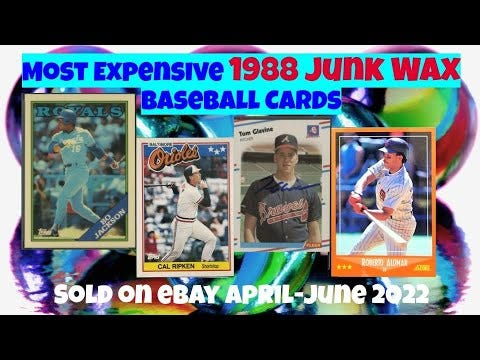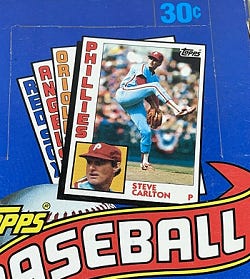We’ve done a couple of videos focused squarely on the Junk Wax era over on YouTube recently, including this rundown of “expensive” 1988 eBay sales:
If you’re anything like me, the Junk Wax Era — roughly 1987 through 1994 — holds some pretty sweet hobby memories, and maybe also some hard lessons learned in the realm of supply and demand.
And, while baseball cards from 1988 may truly feel like junk today, at least to some folks, they were once all the rage … especially at card shows.
I mean …
Do you remember the outright electricity that jolted your body when you stepped through the smoke-filled doorway of a 1980s baseball card show?
It was magical, and the year’s new cards always had their day in the spotlight — in the spring, at least, and sometimes all through the summer if a Don Mattingly or Gregg Jefferies exploded from the wax melee.
While all those memories are stirred up like your brain after a bout with the ol’ Sit n’ Spin, let’s use them to our advantage.
So …
Step back with me now, through the blue haze of time, to a land before Mylar (mostly) and the universal DH … to a realm where pitchers’ arms stayed attached to their bodies through the rigors of 7+ innings per start … to an epoch of retirement funds and college plans lurking under every slab of pink, dusty bubblegum.
Come with me to a 1980s baseball card show, and drink in its splendors …
Grab Bags
Right there, center stage, as you walk through the front door, is none other than the show “promoter” himself, decked out in his soiled Cincinnati Reds jersey and sweat-stained Brooklyn Dodgers cap and enough rings to almost cover the sasquatchian tufts of hair erupting from his sausage fingers.
Spread out before him are dozens — hundreds, maybe — of lunch-sack-sized paper bags, each with its top folded closed. A hand-written poster board proclaims:
Grab bags: $1 each
Guaranteed to contain one All-Star or Hall of Fame player
Minimum value: $1
Maximum value: ???
Find the Pete Rose rookie card!
“Big Lou’s Cards,” another sign hanging on the front of the table says.
Big Lou eyes you for a couple of seconds, then jams half his Philly cheesesteak into his mouth.
“Lookin’ for anything in particular?” he mumble-spits, even though his table features only the grab bags, flyers for the next show, and more stains.
“Just looking right now.”
Lou nods, washes down the sandwich with a fistful of pizza and a swig from a glass bottle of Mountain Dew.
“Got a good deal on grab bags right now,” he says. “Three for two bucks.”
You bite, hoping you’ll find the Rose rookie, but figuring you’ll at least come out a dollar ahead.
As you step to the side to open your loot, you hear Lou greet the next customer, and his mouth still sounds full.
Your bounty?
Bag 1: forty-nine 1987 Topps commons, plus a 1988 Donruss Dan Plesac All-Star card
Bag 2: thirty-one 1983 Fleer football “team action” cards, plus a 1985 Topps Glossy All-Star Paul Owens card
Bag 3: twenty-five Fleer logo stickers, including one from 1982 that show part of the word “All-Star” on the back of the card — maybe you’ll finish the puzzle after a few more years’ worth of grab bags
Broders
The show consists of about 40 eight-foot tables, all set up as a rectangle around Big Lou in the middle.
Down in the back corner of the first leg, past the kid who’s about your age and selling 1986 Topps Vince Coleman and 1985 Orel Hershiser rookie cards for $2 a pop, past the two empty tables of no-shows, past the table that’s so jam-packed with everything you can’t see anything, sits the used-car salesman with the best-looking cards in the joint.
Perfect, crystal-clear full-bleed photos of your favorite players in settings and poses you’ve never seen before. No clunky design elements to ruin the vista. Rounded borders that are just so cool.
And you can see everything Mr. Plaid-Polo-Shirt has to offer because he has each card laid out face-up on his turf-green tablecloth, and you’re amazed at how many different cards can fit into such a small space.
Each little work of art costs only a buck, and you want them all, but you’re down to $8 after your grab-bag splurge. Maybe you buy one or two Broders — that’s what the jalopy peddler calls them — if you can find just the right shot of Kevin Seitzer or Dave Parker.
Cheap Wax, First-Run
New wax is everywhere in this place, and there seems to be a bit of collusion going on — 50 cents a pack is the going rate for a pack on the floor, no matter what the price on the Topps or Fleer or Donruss box might say.
But there’s usually at least one guy who is selling at the MSRP.
He’s got floppy, dusty blond hair, a deep red tan, kind eyes, and a build like a Wiffle Ball bat. He’s wearing khaki shorts and a pastel golf shirt.
“Those Tigers are something else, man,” is his greeting as you step in front of his table. It smells like the beach when he talks, even though the show is basically in the middle of a corn field and you have no idea what the beach smells like.
You nod and smile, thinking that he’s right … no matter if the year is 1984 or 1987 or 1989.
You buy a pack or ten and feel a little guilty for being sort of mad that the price went up five cents from last year.
Thirty cents for a pack of baseball cards? Or forty? Might as well be fifty, huh?
Commons Bins
A bunch of those dealers peddling their 50-cent wax are sitting there opening pack after pack of their own, just taunting you. They pull the stars and rookies and plop the commons in a “monster” box or a big beat-up cardboard box or a steamer trunk.
The gum?
Most of them just stack it to the side as a lure for unsuspecting collector kids. Some jam it in their mouths and chomp away, giving Big Lou a run for his bad-table-manners money. The really sadistic ones throw it away.
Of course, the dealers can’t very well throw away baseball cards, so all that dreck that got shot into a box become the “commons bin,” where set builders and bargain hunters can rummage around looking for something that floats their boats on the cheap.
If you run into a compulsive sorter, you might spend a couple minutes looking for the common you need.
If not, well, this might be your Waterloo, timewise.
100-Card Lots
You’ve made the last quarter turn, heading for door, and you still have $1.67 burning a hole in your pocket. But you have what you came for — three bags of lottery winnings, three sticks of gum in your cheek, a Bobby Meacham rookie card and Ozzie Smith All-Star among your 1984 Topps wax pulls, and some pretty nifty-looking woodgrain commons.
That surplus can be a head start on the next show. Besides, you can see everything laid out between you and the exit, and there’s nothing you can’t live without — an old RC can with Jason Thompson on it, some dogeared issues of Baseball Digest, a couple more empty tables, and a table with several stacks of loose cards just sitting there.
It’s all pass-by-able.
But then, as you get close to that last table, the one with the stacks, you see a familiar face — Kurt Stillwell. It’s his 1986 Topps Traded rookie card.
You nudge that beauty to the side and find … another Stillwell. Under that one, another.
“You can have the 100-card lot for $25,” says the middle-aged man with wire-rim glasses and big belly tamed under a button-down shirt. He’s wearing slacks and looks like he might be a teacher or lawyer or store manger.
Serious. Clean. Quiet. Confident.
A boss, for sure.
“Hundred-card lot?” you ask, unsure.
“Yes, it’s a great way to invest in a player.”
Invest?
“Can I buy just one?”
The thick man smiles, but shakes his head.
“No, afraid not. This is a volume game.”
This fellow is speaking a different language, but you like it.
“What do you have for $1.67?”
You walk away with 50 leftover 1982 Fleer Bruce Berenyis, 17 cents, and a $25 goal.
—
Yes, I know I’ve mixed up the years and put new cards in the hopper with old cards when they can’t be there because they weren’t born yet and made old cards come after the new and twisted it all up and turned the whole thing into a cardboard blender.
But that’s the way card shows are, right? A place and time where place and time don’t matter at all, where all of baseball history, all of hobby history come together in whatever order the dealers appear.
And then, when you buy a single here and a pack there and dream about a stack of cards there, you create your own order, and you can shuffle it any time you want.
So, go ahead and shuffle …
What do YOU remember most about card shows from the 1980s?
I’d love to hear your memories!
Until next time, may all your wax packs yield a 1988 Topps Bo Jackson, or something of comparable beauty.
Thanks for reading.
Adam








